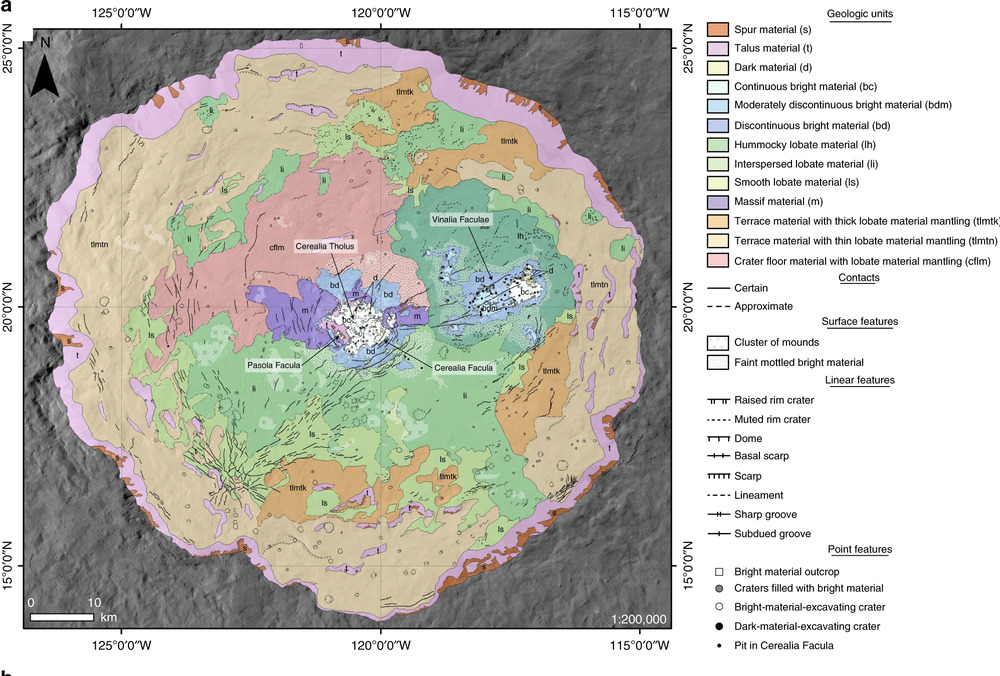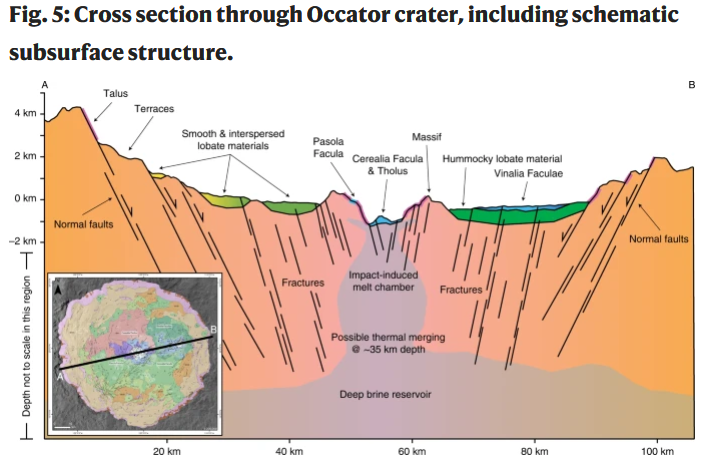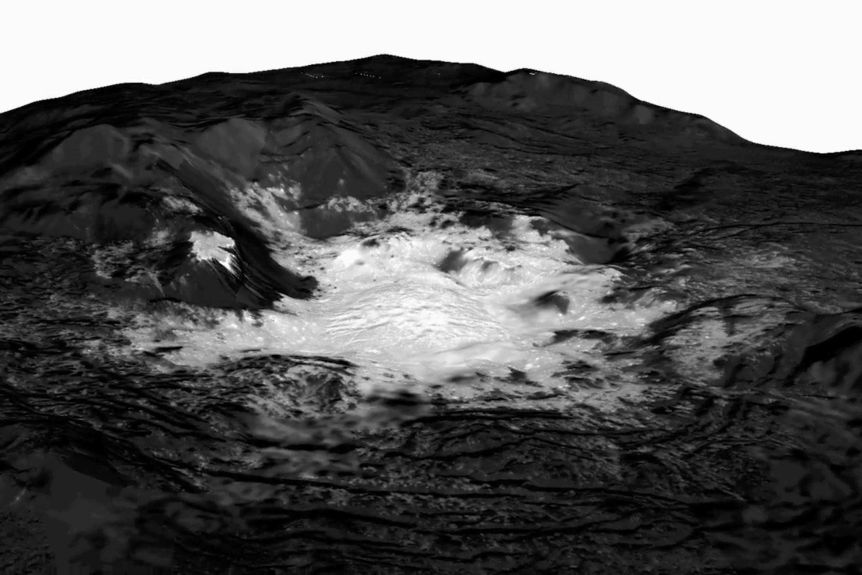dv said:
Ceres: An Ocean World in the Asteroid Belt
By Eric BetzAugust 11, 2020 5:30 AM
Remnants of an ancient water ocean are buried beneath the icy crust of dwarf planet Ceres — or, at least, lingering pockets of one. That’s the tantalizing find presented August 10 by scientists working on NASA’s Dawn mission. Their research was laid out in a series of papers published in Nature.
By far, Ceres is the largest object in the asteroid belt, which girdles the inner planets between Mars and Jupiter. But unlike its rockier neighbors, Ceres is a giant ice ball. It holds more water than any world in the inner solar except for Earth. That knowledge had long led some astronomers to suspect Ceres may have once had a subsurface ocean, which is part of the reason NASA sent the Dawn spacecraft there.
However, some models predicted that Ceres’ ocean would have frozen long ago, forming the world’s thick, icy crust.
Now, after five years studying a series of strange surface features around recently-formed craters, astronomers believe they’re seeing signs of a large, subsurface body of briny liquid. Variations in Ceres’ gravitational field back that up, implying that the underground reservoir of salty water may stretch horizontally beneath the ice for hundreds of miles and reach depths of roughly 25 miles (40 kilometers).
“Past research revealed that Ceres had a global ocean, an ocean that would have no reason to exist and should have been frozen by now,” study co-author and Dawn team member Maria Cristina De Sanctis of the National Institute of Astrophysics in Rome tells Astronomy. ”These latest discoveries have shown that part of this ocean could have survived and be present below the surface.”
If future missions can confirm the results, it will mean that there’s a very salty, very muddy body of liquid somewhere around the size of Utah’s Great Salt Lake on a dwarf planet that’s just 590 miles (950 km) across — roughly the size of Texas.
> Remnants of an ancient water ocean are buried beneath the icy crust of dwarf planet Ceres — or, at least, lingering pockets of one. That’s the tantalizing find presented August 10 by scientists working on NASA’s Dawn mission. Their research was laid out in a series of papers published in Nature.
It’s not in Google Scholar yet. It’s more recent than the most recent edition of Nature is August 6. It’s not in arXiv, which has no articles about Ceres this year.
Aha, found it. https://www.nature.com/collections/agdgfadcag
There are 7 research articles from 10 Aug. Of those, two are open access.
“The spatial distribution of the hydration level of these salts suggests that they surfaced a maximum of a few centuries ago.” – Not open access.
That’s good enough for me. Ceres has subsurface water.
“may have formed by freezing of water-rich impact-induced melt” – Not open access.
“the central faculae were sourced in an impact-induced melt chamber, with a contribution from the deep brine reservoir, while the Vinalia Faculae were sourced by the deep brine reservoir alone.” – Open access.
“The area experienced extensive cryovolcanism less than nine million years ago that lasted several million years, indicating recent geological activity.” – Not open access.
—-
Let’s start with open access article https://www.nature.com/articles/s41467-020-17184-7 Impact heat driven volatile redistribution at Occator crater on Ceres as a comparative planetary process.
“formation either as impact-derived deposits reminiscent of those observed in large craters on the Moon and Earth, or as post-impact volcanic outflows from deep subsurface water-rich reservoirs.” Interestingly, they’re not talking hare about the main bright regions in Occator crater, but about hardly visible features such as mounds south east of that but still within the crater. These other features are ascribed to “frost heave”.
This article continually keeps quoting Moon and Mars, which slightly reduces its credibility because it risks false analogy.
“an impact melt that is mud-like in composition and consistency. Thus, impact melts on Ceres are likely much wetter than on terrestrial planets.”
The dominant bright feature in Occator is not mud-like, it’s not the colour of mud. But that said, it must be wetter than mud for evaporation to leave behind a salt crust.
“The inferred age of Occator is from a few to as much as ~20 myr. All floor units are extensively pitted with small roughly circular depressions <500 m across that could be impact or subsurface volatile release pits.” “are inferred to be due to general impact cratering”.
“Limited occurrences of definitive irregularly shaped non-impact endogenic pitting are now resolved across Occator. These take the form of ovoid to kidney-shaped depressions <250 m wide”.
“numerous smaller-scale curvilinear and sinuous troughs typically ≤100 m wide and up to 7 km long”. Rivers? or not? “Some of the sinuous troughs must be fractures as stereo reveals they cross over prominent topographic rises”. Not. “In several cases, these sinuous troughs have branching patterns, are spatially associated with one or more of these endogenic pits described above, and are flanked by low scarp-bounded layers, possibly implicating subsurface volatile release and outflow of minor amounts of post-emplacement melts through surface vents and fissures.” Or possible rivers.
“The differences in surface morphology of impact deposits on Ceres compared with the Moon and Mars shown here must be related to the higher fraction of salts and water ice in Ceres’ outer layers. The irregular pits and pit clusters, thin lava-like mud flows, and sinuous troughs at Occator are both less common and are different in expression to those within lunar and Mars craters.” “pits are larger and more closely spaced on Mars and Vesta”.
There’s an amusing linguistic gaffe where they claim that “the composition of Ceres’ outer layers strongly controls how hydrothermal processes operate on … Mars and Earth”! Oops.
—-
On to the second open access article https://www.nature.com/articles/s41467-020-15973-8 The varied sources of faculae-forming brines in Ceres’ Occator crater emplaced via hydrothermal brine effusion.
Geological map of Occator Crater.



“crater-count-derived model ages suggest that Cerealia Facula began to form ~8 million years ago, while formation of Vinalia Faculae began ~4 million years ago. There is some evidence for possible local reactivation/resurfacing on Cerealia Facula ~1–2 million years ago”.
What! Three different ages from a single asteroid impact.
“the frequently diffuse nature of the deposits make absolute age dating of the faculae notoriously difficult, and prone to relatively large uncertainties”
Oh. That makes more sense.
“the deep brine reservoir (>35 km deep) would be under greater pressures, keeping more volatiles in solution until they neared the surface”



